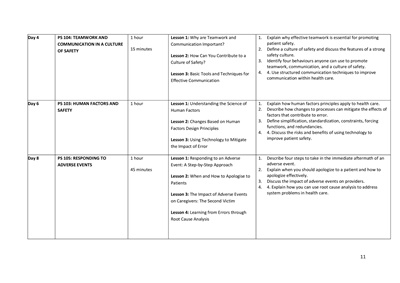
11
Day 4 PS 104: TEAMWORK AND
COMMUNICATION IN A CULTURE
OF SAFETY
1 hour
15 minutes
Lesson 1: Why are Teamwork and
Communication Important?
Lesson 2: How Can You Contribute to a
Culture of Safety?
Lesson 3: Basic Tools and Techniques for
Effective Communication
1. Explain why effective teamwork is essential for promoting
patient safety.
2. Define a culture of safety and discuss the features of a strong
safety culture.
3. Identify four behaviours anyone can use to promote
teamwork, communication, and a culture of safety.
4. 4. Use structured communication techniques to improve
communication within health care.
Day 6 PS 103: HUMAN FACTORS AND
SAFETY
1 hour
Lesson 1: Understanding the Science of
Human Factors
Lesson 2: Changes Based on Human
Factors Design Principles
Lesson 3: Using Technology to Mitigate
the Impact of Error
1. Explain how human factors principles apply to health care.
2. Describe how changes to processes can mitigate the effects of
factors that contribute to error.
3. Define simplification, standardization, constraints, forcing
functions, and redundancies.
4. 4. Discuss the risks and benefits of using technology to
improve patient safety.
Day 8 PS 105: RESPONDING TO
ADVERSE EVENTS
1 hour
45 minutes
Lesson 1: Responding to an Adverse
Event: A Step-by-Step Approach
Lesson 2: When and How to Apologise to
Patients
Lesson 3: The Impact of Adverse Events
on Caregivers: The Second Victim
Lesson 4: Learning from Errors through
Root Cause Analysis
1. Describe four steps to take in the immediate aftermath of an
adverse event.
2. Explain when you should apologize to a patient and how to
apologize effectively.
3. Discuss the impact of adverse events on providers.
4. 4. Explain how you can use root cause analysis to address
system problems in health care.